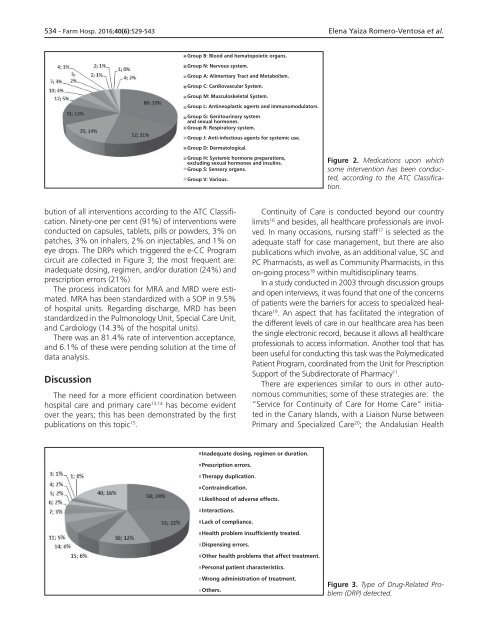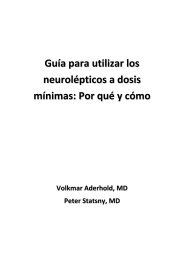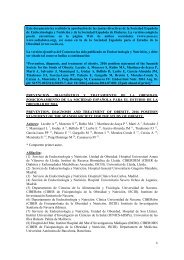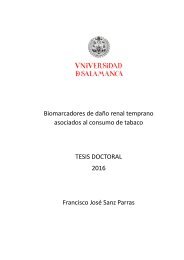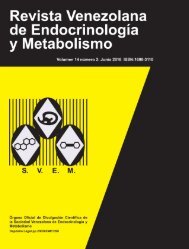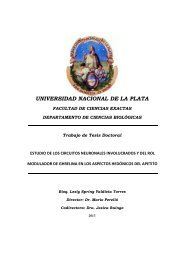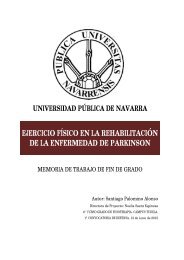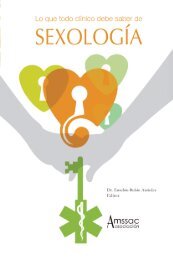Noviembre-Diciembre
156_v40n6(1)
156_v40n6(1)
Create successful ePaper yourself
Turn your PDF publications into a flip-book with our unique Google optimized e-Paper software.
534 - Farm Hosp. 2016;40(6):529-543 Elena Yaiza Romero-Ventosa et al.<br />
Group B: Blood and hematopoietic organs.<br />
Group N: Nervous system.<br />
Group A: Alimentary Tract and Metabolism.<br />
Group C: Cardiovascular System.<br />
Group M: Musculoskeletal System.<br />
Group L: Antineoplastic agents and immunomodulators.<br />
Group G: Genitourinary system<br />
and sexual hormones.<br />
Group R: Respiratory system.<br />
Group J: Anti-infectious agents for systemic use.<br />
Group D: Dermatological.<br />
Group H: Systemic hormone preparations,<br />
excluding sexual hormones and insulins.<br />
Group S: Sensory organs.<br />
Group V: Various.<br />
Figure 2. Medications upon which<br />
some intervention has been conducted,<br />
according to the ATC Classification.<br />
bution of all interventions according to the ATC Classification.<br />
Ninety-one per cent (91%) of interventions were<br />
conducted on capsules, tablets, pills or powders, 3% on<br />
patches, 3% on inhalers, 2% on injectables, and 1% on<br />
eye drops. The DRPs which triggered the e-CC Program<br />
circuit are collected in Figure 3; the most frequent are:<br />
inadequate dosing, regimen, and/or duration (24%) and<br />
prescription errors (21%).<br />
The process indicators for MRA and MRD were estimated.<br />
MRA has been standardized with a SOP in 9.5%<br />
of hospital units. Regarding discharge, MRD has been<br />
standardized in the Pulmonology Unit, Special Care Unit,<br />
and Cardiology (14.3% of the hospital units).<br />
There was an 81.4% rate of intervention acceptance,<br />
and 6.1% of these were pending solution at the time of<br />
data analysis.<br />
Discussion<br />
The need for a more efficient coordination between<br />
hospital care and primary care 13,14 has become evident<br />
over the years; this has been demonstrated by the first<br />
publications on this topic 15 .<br />
Continuity of Care is conducted beyond our country<br />
limits 16 and besides, all healthcare professionals are involved.<br />
In many occasions, nursing staff 17 is selected as the<br />
adequate staff for case management, but there are also<br />
publications which involve, as an additional value, SC and<br />
PC Pharmacists, as well as Community Pharmacists, in this<br />
on-going process 18 within multidisciplinary teams.<br />
In a study conducted in 2003 through discussion groups<br />
and open interviews, it was found that one of the concerns<br />
of patients were the barriers for access to specialized healthcare<br />
19 . An aspect that has facilitated the integration of<br />
the different levels of care in our healthcare area has been<br />
the single electronic record, because it allows all healthcare<br />
professionals to access information. Another tool that has<br />
been useful for conducting this task was the Polymedicated<br />
Patient Program, coordinated from the Unit for Prescription<br />
Support of the Subdirectorate of Pharmacy 11 .<br />
There are experiences similar to ours in other autonomous<br />
communities; some of these strategies are: the<br />
“Service for Continuity of Care for Home Care” initiated<br />
in the Canary Islands, with a Liaison Nurse between<br />
Primary and Specialized Care 20 ; the Andalusian Health<br />
Inadequate dosing, regimen or duration.<br />
Prescription errors.<br />
Therapy duplication.<br />
Contraindication.<br />
Likelihood of adverse effects.<br />
Interactions.<br />
Lack of compliance.<br />
Health problem insufficiently treated.<br />
Dispensing errors.<br />
Other health problems that affect treatment.<br />
Personal patient characteristics.<br />
Wrong administration of treatment.<br />
Others.<br />
Figure 3. Type of Drug-Related Problem<br />
(DRP) detected.


